Abstract
This manuscript investigates the degradation efficiency of a cytostatic agent imatinib mesylate (IM) by Fenton process. The objective of the study is to determine the effect of initial concentrations of hydrogen peroxide, ferrous ion and IM on the degradation process of IM. In this context, the overall research is conducted in two stages. The first stage of experiments involves the evaluation of the experimental parameters impact on the IM removal using the factorial design; whereas the second one includes the optimization conditions for IM degradation using Doehlert design. Different concentrations of H2O2 (10–50 mmol L−1), Fe(II) (0.5–3 mmol L−1) and IM (0.045–1.7 mmol L−1) are adopted both to assess the main effects of factors and their interactions on the anticancer destruction and to establish the optimum process variables that ensure its total removal. The factorial matrix considering different combinations of factors and levels demonstrates that the concentrations of Fe(II) and IM are the most determining parameters on the removal of the target molecule. The Doehlert matrix reveals that the maximum IM abatement is predicted to be 100.59% (± 0.63) when the optimized reaction conditions are set at 30 mmol L−1 for H2O2 and 2.5 mmol L−1 for Fe(II).






Similar content being viewed by others
References
Ferrando-Climent L, Rodriguez-Mozaz S, Barceló D (2014) Incidence of anticancer drugs in an aquatic urban system: from hospital effluents through urban wastewater to natural environment. Environ Pollut 193:216–223
Mater N, Geret F, Castillo L, Faucet-Marquis V, Albasi C, Pfohl-Leszkowicz A (2014) In vitro tests aiding ecological risk assessment of ciprofloxacin, tamoxifen and cyclophosphamide in range of concentrations released in hospital wastewater and surface water. Environ Int 63:191–200
Zhang J, Chang VWC, Giannis A, Wang JY (2013) Removal of cytostatic drugs from aquatic environment: a review. Sci Total Environ 445–446:281–298
Wang XH, Lin AYC (2014) Is the phototransformation of pharmaceuticals a natural purification process that decreases ecological and human health risks? Environ Pollut 186:203–215
Santos MSF, Alves A, Madeira LM (2011) Paraquat removal from water by oxidation with Fenton’s reagent. Chem Eng J 175:279–290
Oturan MA, Aaron JJ (2014) Advanced oxidation processes in water/wastewater treatment: Principles and applications: A review. Crit Rev Environ Sci Technol 44(23):2577–2641. https://doi.org/10.1080/10643389.2013.829765
Neyens E, Baeyens J (2003) A review of classic Fenton’s peroxidation as an advanced oxidation technique. J Hazard Mater 98:33–50
Bagal MV, Gogate PR (2014) Wastewater treatment using hybrid treatment schemes based on cavitation and Fenton chemistry: a review. Ultrason Sonochem 21:1–14
Babu Ponnusami A, Muthukumar K (2014) A review on Fenton and improvements to the Fenton process for wastewater treatment. J Environ Chem Eng 2:557–572
Governo M, Santos MSF, Alves A, Madeira LM (2016) Degradation of the cytostatic 5-fluorouracil in water by Fenton and photo-assisted oxidation processes. Environ Sci Pollut Res 24:844–854
Ramirez JH, Costa CA, Madeira LM (2005) Experimental design to optimize the degradation of the synthetic dye orange II using Fenton’s reagent. Catal Today 107–108:68–76
Haber F, Weiss J (1934) The catalytic decomposition of hydrogen peroxide by iron salts. Proc R Soc Lond A 147(861):332–351
Wu Y, Zhou S, Qin F, Zheng K, Ye X (2010) Modeling the oxidation kinetics of Fenton’s process on the degradation of humic acid. J Hazard Mater 179:533–539
Sina MA, Mohsen M (2017) Advances in Fenton and Fenton based oxidation processes for industrial effluent contaminants control—a review. Int J Environ Sci Nat Res 2(4):555–594. https://doi.org/10.19080/IJESNR.2017.02.555594
Brillas E, Sirés I, Oturan MA (2009) Electro-Fenton process and related electrochemical technologies based on Fenton’s reaction chemistry. Chem Rev 109:6570–6631
Kuo WG (1992) Decolorizing dye wastewater with Fenton’s reagent. Water Res 26:881–886
Kavitha V, Palanivelu K (2005) Destruction of cresols by Fenton oxidation process. Water Res 39:3062–3072
Bianchi F, Caffarri E, Cavalli S, Lagrastac C, Musci M, Quaini F, Savi M (2013) Development and validation of an high performance liquid chromatography-tandem mass spectrometry method for the determination of imatinib in rat tissues. J Pharm Biomed Anal 73:103–107
Muruganandham M, Swaminathan M (2004) Decolourisation of reactive orange 4 by Fenton and photo-Fenton oxidation technology. Dyes Pigment 63:315–321
Bensalah W, Feki M, Wery M, Ayedi HF (2010) Thick and dense anodic oxide layers formed on aluminum in sulphuric acid bath. J Mater Sci Technol 26:113–118
Haaland DP (1989) Experimental design in biotechnology. Marcel Dekker Inc, New York
Hammami S, Oturan N, Bellakhal N, Dachraoui M, Oturan MA (2007) Oxidative degradation of direct orange 61 by electro-Fenton process using a carbon felt electrode: application of the experimental design methodology. J Electroanal Chem 610:75–84
Zaviska F, Drogui P, Blais JF, Mercier G, Lafrance P (2011) Experimental design methodology applied to electrochemical oxidation of the herbicide atrazine using Ti/IrO2 and Ti/SnO2 circular anode electrodes. J Hazard Mater 185:1499–1507
Myers RH, Montgomery DC (2002) Response surface methodology: process and product optimization using designed experiments, 2nd edn. Wiley, New York
Mansour D, Fourcade F, Soutrel I, Hauchard D, Bellakhal N, Amarane A (2015) Mineralization of synthetic and industrial pharmaceutical effluent containing trimethoprim by combining electro-Fenton and activated sludge treatment. J Taiwan Inst Chem Eng 53:58–67. https://doi.org/10.1016/j.jtice.2015.02.022
de Sena AR, Valasques Júnior GL, Barretto IKSP, Assis SA (2012) Application of Doehlert experimental design in the optimization of experimental variables for the Pseudozyma sp. (CCMB 306) and Pseudozyma sp. (CCMB 300) cell lysis. Food Sci Technol (Campinas) 32:761–767
Sayyad SA, Panda BP, Javed S, Ali M (2007) Optimization of nutrient parameters for lovastatin production by Monascus purpureus MTCC 369 under submerged fermentation using response surface methodology. Appl Microbiol Biotechnol 73:1054–1058
Nidheesh PV, Gandhimathi R (2012) Trends in electro-Fenton process for water and wastewater treatment: an overview. Desalination 299:1–5
Mansoorian HJ, Bazrafshan E, Yari A, Alizadeh M (2014) Removal of azo dyes from aqueous solution using Fenton and modified Fenton processes. Health Scope 3(2):15507. https://doi.org/10.17795/jhealthscope-15507
Acknowledgements
This research project is in the framework of a doctoral thesis MOBIDOC belonging to the Project for the Support of the Research and Innovation System in Tunisia (PASRI) which is funded by the European Union and managed by the National Agency for scientific Research Promotion (ANPR). The authors gratefully acknowledge the members of the Oncology Department at Neapolis Pharma-Medis Group especially Mr. Mohamed Amine BOUJBEL, Mr. Aymen JELASSI and Mr. Riadh BANI for their encouragement and support to carry out this work.
Author information
Authors and Affiliations
Corresponding author
Ethics declarations
Conflict of interest
Authors declare no conflict of interest.
Rights and permissions
About this article
Cite this article
Ghrib, F., Saied, T. & Bellakhal, N. Experimental Design Methodology Applied to the Degradation of a Cytostatic Agent the Imatinib Mesylate Using Fenton Process. Chemistry Africa 2, 103–111 (2019). https://doi.org/10.1007/s42250-018-00033-y
Received:
Accepted:
Published:
Issue Date:
DOI: https://doi.org/10.1007/s42250-018-00033-y




